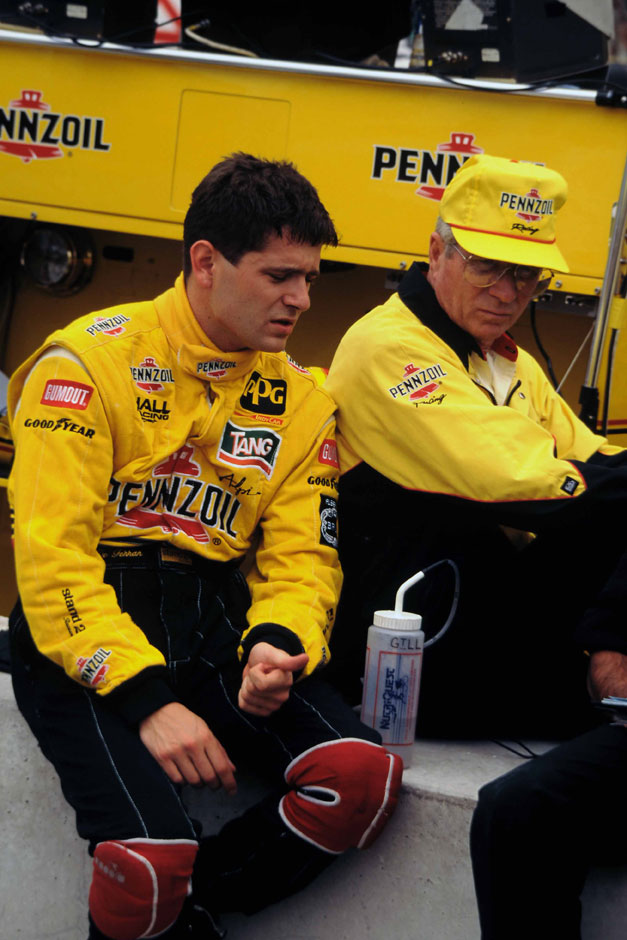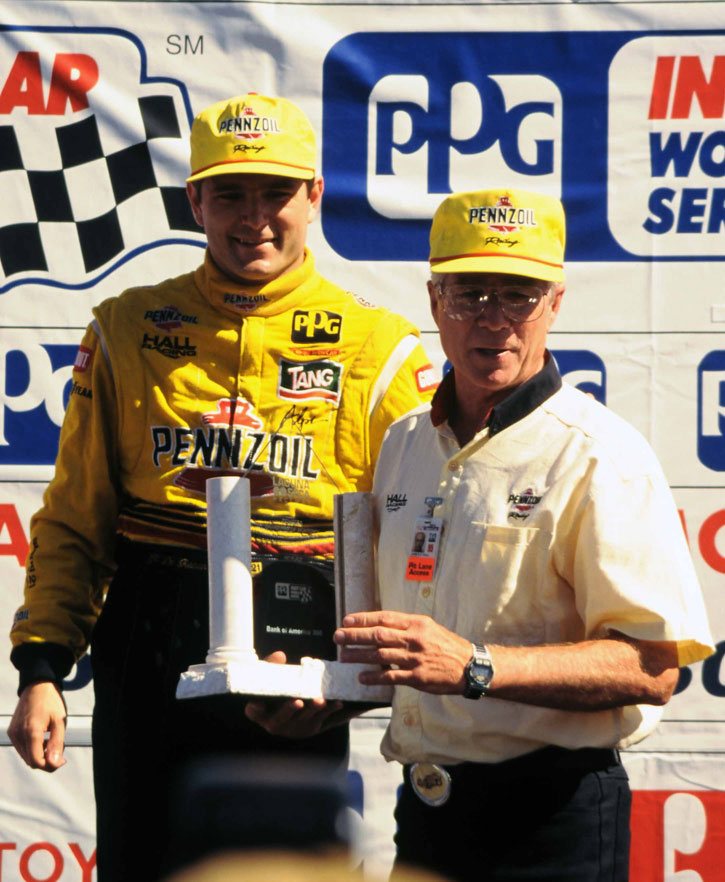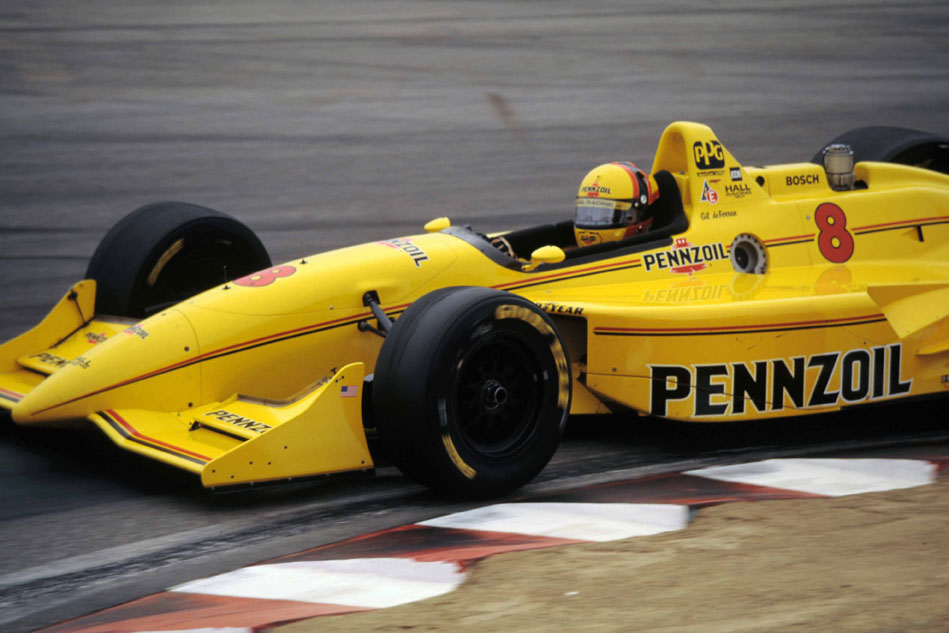Jim Hall on Gil de Ferran
 |
| Gil de Ferran and Jim Hall |
As part of the special celebrations to mark Gil de Ferran's final appearance as a race car driver, which comes next weekend in the American Le Mans Series’ season finale at Mazda Raceway Laguna Seca, the Brazilian is honoring the role US motorsport legend Jim Hall played in his career. Hall is famously the inspiration behind the iconic Chaparral sports cars of the 1960s and ’70s – pioneering machines that totally changed the face of race car engineering. More recently, though, he was an IndyCar entrant and the man who gave de Ferran his first competitive drive in North America.
It was while racing for Hall that de Ferran won the Rookie of the Year award in 1995, scoring a maiden win at Laguna Seca. The following season de Ferran won again at Cleveland to give Hall a final victory as a team owner. Paying tribute to Hall, de Ferran has adopted the No. 66 – as displayed on so many of Chaparral's successful sports cars – for his own de Ferran Motorsports team. Now, to mark de Ferran’s final race behind the wheel, the No. 66 XM Radio de Ferran Motorsports Acura ARX-02a will compete at the Monterey Sports Car Championships presented by Patr¢n in Chaparral’s illustrious white livery.
 |
| Gil de Ferran and Jim Hall |
 |
 |
Jim Hall will be present with several of his celebrated Chaparrals. Here are his personal thoughts about what’s sure to be a very evocative and emotional weekend at the California venue.
Question: What are your memories of working with Gil de Ferran for those two years in Indy cars?
Jim Hall: One of the things I always enjoyed about Gil was his interest in the cars as well as his really strong work ethic. He always wants to do the best he can do for the team and himself – it’s a real joy to work with someone like that.
Q: Were those two wins the high points?
JH: No question about it, those wins we had at Laguna in 1995 and Cleveland in 1996 were very special to us both.
Q: How do you feel about the de Ferran Motorsports entry running an evocative Chaparral livery at Laguna Seca in deference to the role you played in helping Gil’s career?
JH: It’s very nice that Gil has chosen to honor me in some way at what’s obviously a very special event for him. We certainly had a good run with him for a couple of years before he got an opportunity to move on to a better paying drive. He did a great job for us and I really enjoyed watching his career develop thereafter. It gave me a lot of satisfaction seeing him do so well.
He kindly gives me a lot of credit for the part I played in boosting his career along but Gil did it for himself – he’s the guy with the talent, the skill and the work ethic needed to succeed. I give him at least 99 percent of the credit … but I greatly appreciate the fact that he’s thankful for the part I played in his career. But certainly he did it for himself.
Q: Gil also pays great tribute to legendary team owner Roger Penske for whom he won two IndyCar titles in 2000 and 2001 and the Indianapolis 500 in 2003. Roger also, of course, has strong ties with Chaparral having raced for the team with you back in the ’60s.
JH: Yes, Roger and I raced against each other as amateurs a long time ago and have known and competed against each other a good deal over the years. It’s been a long enjoyable relationship; we are still good friends. I was really pleased that Gil worked out a relationship with Roger that was successful for both of them.
Q: As well as running a special livery at Laguna Seca, Gil has run the 66 number made famous by Chaparral on his American Le Mans Series cars for the past two seasons. What’s the history behind the number 66?
JH: The 66 was actually a random thing. I was taking a car to Nassau in the ’50s. It was a new car coming from England that I first saw at the dock. There was a young man standing there with a paintbrush in his hand who asked me if I would like him to paint the numbers on it. I looked in the program and I had been assigned 66, so I said, ‘Sure – paint it on.’ That number then stayed with the car and later I thought, ‘I like that number and no one else seems to be using it, so I just stuck with it.’ Really it was just a random number but it came to mean a lot to me over the years because I ran it wherever I could. It was nice when Gil called last year and said, ‘What would you think about me running number 66 on my car?’ I replied, ‘If you want to then that’s great – go for it.’ So I was pleased with that.
Q: The No. 66 XM Radio de Ferran Motorsports Acura ARX-02a will race in the famous Chaparral white at Laguna Seca to mark Gil's final race – what are the origins of the evocative white livery?
JH: It was originally called ‘GM fleet white’ – I guess they put it on their fleet cars. It’s not quite a pure white; it’s a little bit off. It doesn’t look like a refrigerator as it has a very small amount of yellow in it. The reason we ran it and liked it was because we live out here in Texas where the sun shines hard every day, and if you sit in a dark painted car it gets hot. We started racing in the Southwest and at circuits like Riverside and Las Vegas as well as other places where it was a hundred degrees, so white was a pretty practical color.
Q: The history books suggest that Laguna Seca is a pretty special place for you and thus the perfect backdrop for a farewell event like the one Gil is planning.
JH: Yes, I won races there in the early ’60s; Roger and Phil Hill also won there in Chaparrals and Gil won there for us in IndyCars – so it’s a special place for both of us. I held the lap record there for years. Laguna is one of my favorite tracks in the country and a great spot for us to enjoy Gil’s last race.
Q: To mark the occasion, three pretty special cars are joining you at Laguna Seca.
JH: We’re bringing the 1995 Pennzoil IndyCar which I believe is Gil’s actual winning chassis from Laguna. We’re also bringing the Chaparral 2 – it looks just about as it did in mid-1965 with fixed aerodynamics. The other car we are bringing is the Chaparral 2E which is our first high-wing CanAm car, and my favorite Chaparral.
The final race in the 2009 American Le Mans Series is the four-hour Monterey Sports Car Championships at Mazda Raceway Laguna Seca in Monterey, Calif. The green flag is scheduled for 2:45 p.m. PT on Saturday, October 10. The race will air on SPEED from 2:30 to 6:30 p.m. ET on Sunday, October 11. Live coverage will be available via American Le Mans Radio presented by Porsche via americanlemans.com, which also will feature Living Timing & Scoring on Racehub. Live coverage also can be heard on Sirius 126 and XM 242. You can follow the Series on Twitter (almsnotes) and on our Facebook page.
